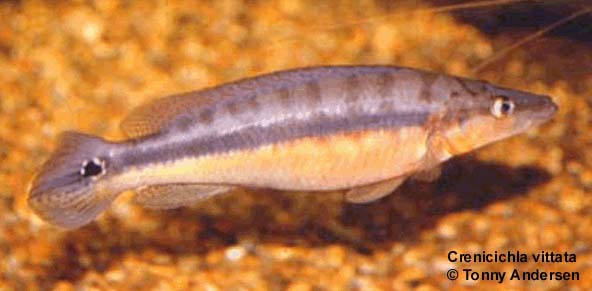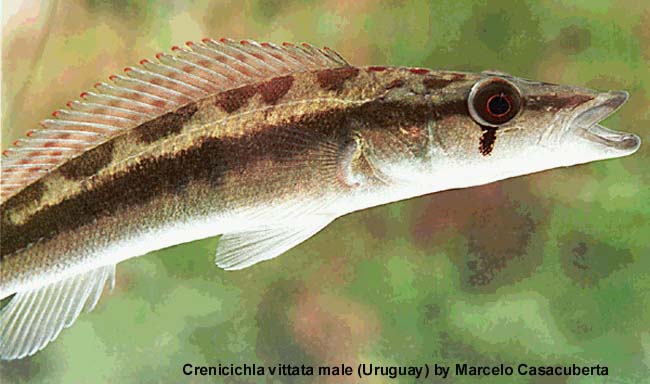| Home | Pikes | Neotropicals | Collecting | Photography | Links | Site map |


Crenicichla vittata Heckel, 1840
Group: Lacustris
Distribution: Paraguay, middle Uruguay and Parana basins.
Type Locality: Rio Cuiaba, Rio Paraguay, South America
Size: 10 - 14 inches
Comments: This infrequently imported southern species is slightly more tolerant of temperature dips than many Crenicichla. It is one of the very few members of this group that has been spawned in aquaria (by Daniel Kerson, California and Uwe Werner, Germany). There is a color morph of this species where the females display red coloring below the lateral band - the ventral flanks of most mature females are yellow or orange. Other than that there appears to be minimal differences between the sexes in this species. Water parameters reported by Werner in its natural habitat was 21-25 C with a KH of 8 and GH of 0 and pH of 8.2. The spawn numbered 200 (Werner) and only 90 for Kerson and the fry were observed contact feeding off the male's head and face. Werner mentions that this species is relatively friendly in aquaria towards other residents, a pleasant surprise. Some authors have placed this fish in the acutirostris group but the suborbital stripe, body shape and scale/fin counts hint towards the lacustris group.
I was able to collect this fish in Uruguay in lakes and ponds connected to Rio Uruguay in the state of Salto. The water in the collecting habitat was warm (88°F), murky, neutral and soft. It was found with C. lepidota, C. missioneira and C. minuano. It is the primary predator in its habitat besides Hoplias and some catfish. In aquaria, this fish is a little slower than other pikes in adjusting to prepared foods, but it soon learns to love pellets. It is not aggresive with each other until it reaches 6 inches - then, if there are enough hiding places, conspecifics of the same gender are suddenly killed, giving you no time to move the hapless victims. Females begin showing their orange ventral flanks at this size. After a year in captivity, my specimens are 6 - 7 inches long and have not spawned yet.
Described in: Annalen des Wiener Museums 2; p 417-419
| Back to ==> Home / Pike Photos / C. vittata |
 Back to Specieslist
Back to Specieslist
 Back to Photo Index
Back to Photo Index
| Home | Pikes | Neotropicals | Collecting | Photography | Links | Site map |

|
http://geocities.datacellar.net/NapaValley/5491
Latest update: 15 June 2002 Comments on this page: kutty at earthlink dot net |